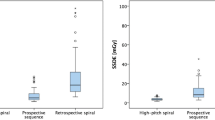Abstract
The aim of this study was to compare the radiation dose and image quality of two CT protocols using a wide-detector computed tomography (WDCT) scanner with single contrast injection for simultaneous evaluation of the aorta and coronary artery. We retrospectively included 104 consecutive patients who underwent coronary and aorta CT angiography. CT Protocols were divided as follows: protocol I, variable helical pitch scan (VHP, n = 31); protocol II, volume scan for coronary artery following helical scan for aorta (VFH, n = 73). Vascular attenuation, noise, signal-to-noise (SNR), and contrast-to-noise ratios (CNR) were compared. Image parameters were measured at coronary artery, thoracic aorta, abdominal aorta, and iliofemoral arteries. Subjective image quality was assessed by two observers. The patient characteristics between groups were similar (P ≥ 0.384). There were no significant differences in any of the quantitative image parameters between the two groups except for the thoracic aorta. Vascular attenuation (469.2 ± 133.6 vs. 605.9 ± 140.2 HU), CNR (24.8 ± 11.4 vs. 37.3 ± 18.5), and SNR (28.4 ± 12.0 vs. 40.6 ± 19.5 ml) were higher in the VHP protocol (P < 0.001 for each) for covering the thoracic aorta. However, all subjective image scores guaranteed diagnostic image quality. The effective radiation dose of the VFH protocol was reduced to 27.2% compared with that of the VHP protocol (443.8 ± 115.8 vs. 706.7 ± 163.7 mGy·cm, P < 0.001). WDCT with single contrast injection allows assessment of both the coronary artery and aorta. The VFH protocol can reduce the radiation dose and preserve the image quality compared with that of the VHP protocol.





Similar content being viewed by others
Abbreviations
- BMI:
-
Body mass index
- CAD:
-
Coronary artery disease
- CCTA:
-
Coronary CT angiography
- CNR:
-
Contrast-to-noise ratio
- ECG:
-
Electrocardiogram
- HU:
-
Hounsfiled unit
- MDCT:
-
Multidetector computed tomography
- NI:
-
Noise index
- SNR:
-
Signal-to-noise ratio
- TAVI:
-
Transcatheter aortiv valve implantation
- VFH:
-
Volume following helical
- VHP:
-
Variable helical pitch
- WDCT:
-
Wide detector computed tomography
References
Malyshev M, Safuanov A, Borovikov D et al (2008) Simultaneous multi-vessel coronary artery bypass grafting, ischemic mitral regurgitation repair and descending aortic aneurysm replacement: analysis of technical points. Interact Cardiovasc Thorac Surg 7(2):315–317
Furutachi A, Rikitake K, Ikeda K et al (2014) Simultaneous thoracoabdominal aortic aneurysm repair and coronary artery bypass grafting through median sternotomy. Ann Thorac Surg 98(3):1081–1083
Eren E, Toker ME, Tuncer A et al (2007) Surgical management of coronary malperfusion due to type a aortic dissection. J Card Surg 22(1):2–6
Neri E, Toscano T, Papalia U et al (2001) Proximal aortic dissection with coronary malperfusion: presentation, management, and outcome. J Thorac Cardiovasc Surg 121(3):552–560
Kawahito K, Adachi H, Murata S et al. (2003) Coronary malperfusion due to type A aortic dissection: mechanism and surgical management. Ann Thorac Surg 76(5):1471–1476; discussion 1476
Kang EJ, Kim SM, Choe YH et al (2014) Takayasu arteritis: assessment of coronary arterial abnormalities with 128-section dual-source CT angiography of the coronary arteries and aorta. Radiology 270(1):74–81
Soto ME, Melendez-Ramirez G, Kimura-Hayama E et al (2011) Coronary CT angiography in Takayasu arteritis. JACC Cardiovasc Imaging 4(9):958–966
Leipsic J, Gurvitch R, Labounty TM et al (2011) Multidetector computed tomography in transcatheter aortic valve implantation. JACC Cardiovasc Imaging 4(4):416–429
Schoenhagen P, Kapadia SR, Halliburton SS et al (2011) Computed tomography evaluation for transcatheter aortic valve implantation (TAVI): imaging of the aortic root and iliac arteries. J Cardiovasc Comput Tomogr 5(5):293–300
Salgado RA, Leipsic JA, Shivalkar B et al (2014) Preprocedural CT evaluation of transcatheter aortic valve replacement: what the radiologist needs to know. Radiographics 34(6):1491–1514
Lewis MA, Pascoal A, Keevil SF et al (2016) Selecting a CT scanner for cardiac imaging: the heart of the matter. Br J Radiol 89(1065):20160376
Matsumoto S, Yamada Y, Hashimoto M et al (2017) CT imaging before transcatheter aortic valve implantation (TAVI) using variable helical pitch scanning and its diagnostic performance for coronary artery disease. Eur Radiol 27(5):1963–1970
Felmly LM, De Cecco CN, Schoepf UJ et al (2017) Low contrast medium-volume third-generation dual-source computed tomography angiography for transcatheter aortic valve replacement planning. Eur Radiol 27(5):1944–1953
Shrimpton PC, Hillier MC, Lewis MA et al (2006) National survey of doses from CT in the UK: 2003. Br J Radiol 79(948):968–980
Li Y, Fan Z, Xu L et al (2012) Prospective ECG-gated 320-row CT angiography of the whole aorta and coronary arteries. Eur Radiol 22(11):2432–2440
Hayter RG, Rhea JT, Small A et al (2006) Suspected aortic dissection and other aortic disorders: multi-detector row CT in 373 cases in the emergency setting. Radiology 238(3):841–852
Author information
Authors and Affiliations
Corresponding author
Ethics declarations
Conflict of interest:
The authors declare that they have no conflict of interest.
Additional information
Publisher's Note
Note Springer Nature remains neutral with regard to jurisdictional claims in published maps and institutional affiliations.
Rights and permissions
About this article
Cite this article
Shin, N., Kim, S.M. & Choe, Y.H. Protocol using wide-detector CT with single contrast injection for the aorta and coronary artery: variable helical pitch versus volume scan following helical scan. Int J Cardiovasc Imaging 35, 1935–1942 (2019). https://doi.org/10.1007/s10554-019-01640-7
Received:
Accepted:
Published:
Issue Date:
DOI: https://doi.org/10.1007/s10554-019-01640-7




